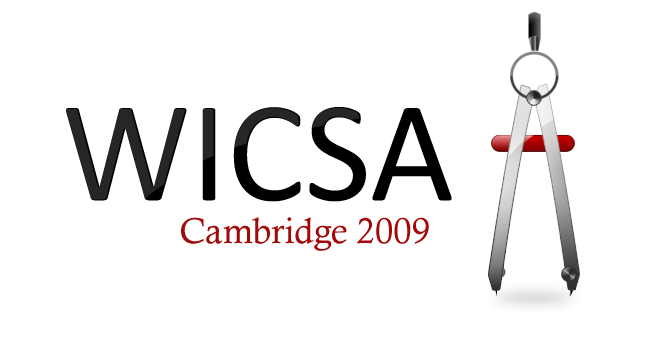

A BoF session is a short, informal forum for discussions related to any aspect of software architecture. Attendees who want to get together with others who share their interests, goals, technologies, environments, or backgrounds are invited to organise and attend a BoF session.
BoFs can be proposed and advertised before the conference or can be convened at the conference when the need for one is recognised. BoFs can be used to continue a discussion that began in another session, for a group to get together to pursue a common interest or just to discuss a range of opinions around a topic.
Each BOF session has a wiki page (see links in the descriptions below).
when: Monday, 14 September 2009, 18:00 – 19:00
organizers: Patricia Lago (Vrije University), Paris Avgeriou (University of Groningen), Rich Hilliard
wiki: BAVF
One of the original intents behind the Recommended Practice for Architectural Description of Software-Intensive Systems (ANSI/IEEE Std 1471 and ISO/IEC 42010) was to provide a basis by which the community could assemble a collection of viewpoints that can be reused across the industry.
This has a clear merit for practitioners: on the one hand architecture viewpoints are necessary for an effective architecture description but may be too expensive to create and update for every single project; on the other hand most projects have large commonalities with respect to the architectural concerns they must address, therefore reusable viewpoints could be easily applied after small customizations across different projects. Especially for small to medium-sized projects, reuse of architecture viewpoints is of paramount importance. The standard also envisioned architecture frameworks that collect one or more reusable viewpoints for a particular domain of application or community of stakeholders. In the on-going revision to the standard, architecture frameworks are being added as a new construct.
Similarly to other attempts at reuse in software engineering, the available collections of reusable architectural viewpoints are very limited. Documenting viewpoints or even frameworks has not yet become part of standard industrial practice. Organizations tend to adopt an existing framework (e.g., Kruchten's 4+1 view model, Rozanski and Woods, or SEI's Views and Beyond). There are only some sporadic attempts from the academic community to define reusable viewpoints but they are far from reaching a critical mass.
The goal of this BoF session is to bring together architects and academics to explore issues behind this problem as well as approaches to its resolution and will emphasize exploring existing industrial architecture viewpoints and frameworks. This BoF is a first step to raise awareness in industrial and academic circles and motivate both communities to contribute reusable viewpoints. We anticipate that having a common mechanism for defining viewpoints offers the prospect of "interoperation" across existing architecture frameworks, and the means to compose new frameworks by mixing and matching viewpoints.
Possible topics for discussion include but are not limited to:
when: Tuesday, 15 September 2009, 18:00 – 19:00
organizers: Paul Brebner (NICTA & ANU), Anna Liu (UNSW)
wiki: BVCSA
This BoF will examine the questions:
when: Tuesday, 15 September 2009, 18:00 – 19:00
organizers: Len Bass and Paul Clements (Software Engineering Institute)
wiki: BBGA
It is long established that architectures are largely shaped by quality attribute requirements: requirements to achieve specific measures of performance, availability, security, modifiability, and so forth. Quality attribute requirements that shape the architecture, which we call architecturally significant requirements, are therefore of prime interest to the architect. But where do they come from? We argue that quality attribute requirements exist to achieve business goals of the developing organization and/or the consuming organization(s). High performance, for example, may be required to out-perform a competitor's system, which serves the organizational goal of staying in business. Efficient computing may be required to satisfy a need for low power consumption, which satisfies the business goal of contributing to society by reducing greenhouse gas emissions.
In this BOF session, we will discuss the role that business goals play in architecture, and how the architect can use business goals to spot missing requirements early in the life cycle. We will begin with a presentation about our research into business goals, and present a prototype method for eliciting and capturing business goals for use by an architect.
when: Tuesday, 15 September 2009, 18:00 – 19:00
organizers: Frank Waldman (Lattix), Clare Pearce (Scientific Computers Ltd)
wiki: BAAL
Join us for a live assessment of the architectures of the popular Firefox and Google Chrome web browsers using Lattix LDM, a architecture analysis tool which been applied to hundreds of large complex commercial software systems. First we will create an accurate blueprint of each system with a Dependency Structure Matrix (DSM) which has been transformed through the application of special partitioning algorithms. We will then compare the architectures utilizing a variety of architectural metrics which focus on the system as a whole and examine its organizational structure, such as connectedness, coupling, cyclicality, and sensitivity to change. We will conclude with a discussion how this analysis could be conducted on your system to identify issues and guide re-engineering efforts.